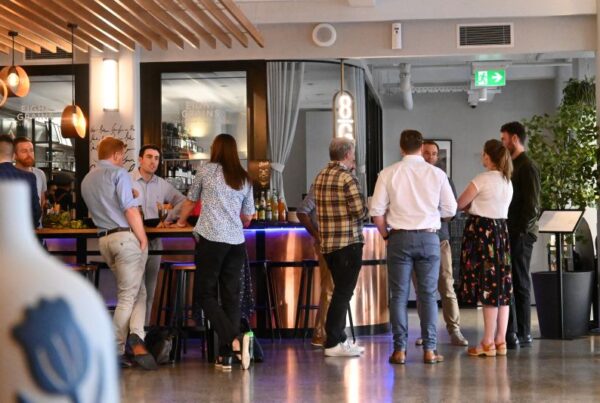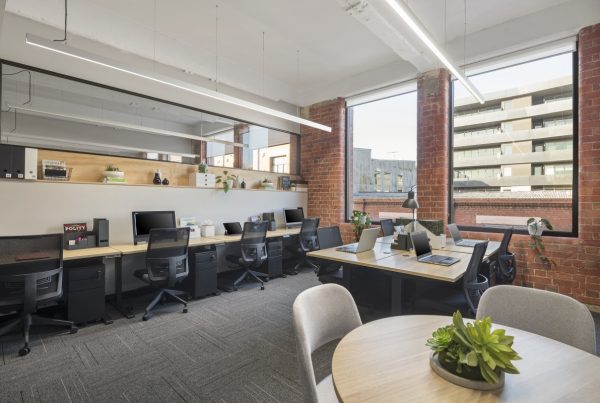
Flexible shared workspaces are quickly becoming the new norm in the office landscape. Initially popular with creatives and start-ups, shared workspaces have evolved to offer a wide spectrum of services supporting various types of businesses. Compared to a stand-alone office lease, shared workspaces offer many benefits such as cost savings, flexibility, and networking opportunities. They also offer a communal environment that may not be as diverse or deliberately inclusive as a traditional industry-specific workplace. In the shared workspace, Individuals or businesses can work alongside each other. This means they can share resources and ideas as these workspaces can foster inclusion, diversity, and in turn creativity. In this article, United Co. will dive into what shared workspace is and its benefits for your growing business.
Traditional Work Space
Historically, a traditional workspace is a physical office space that is leased or owned by a company. These spaces typically have a fixed layout with dedicated workstations and hot desk space for employees. These are generally located in commercial buildings or office complexes. Stability and customizability are the main benefits of this type of workspace, as the company will generally commit to a lease for the long term and has control over the design and layout. They can instill their branding in the office design and sometimes even on the building itself by installing signage and displays. Traditional workspaces offer a sense of security because the company can restrict access and install security systems. A traditional lease gives a business its own office with all the amenities it desires including kitchens, bathrooms showers, changerooms, reception areas, breakout space, meeting space, and of course desk space.
However, there are several disadvantages associated with the traditional office model. Typically, leases are fixed for long terms, requiring tenants to invest significant time and money in office fit-outs. This process can be time-consuming and offers limited flexibility in the long term. For start-ups or small businesses, investing in a fit-out can be particularly challenging as it eats into their limited cash flow. Additionally, besides rent, there are ongoing costs such as new furniture, equipment, utilities, internet, and IT infrastructure. Managing the office also adds to the workload, diverting attention from growing your business to arranging services, maintenance, and repairs.
Once you commit to a traditional workspace, you will be locked into this space for at least a few years. If your company grows faster than expected, your office can quickly become inadequate and limit your growth. Similarly, if you are unable to achieve the projected growth, you may be stuck with an office space that is too large or too expensive, with no options to downsize.
Flexible Shared Workspace
A shared workspace is a flexible office space that is shared by multiple organizations. These spaces can be typically rented on an ad hoc basis, short or long-term. In addition to the office or coworking spaces, shared workspaces generally offer access to various communal workspaces and a range of amenities that members can access throughout their workday. Most contemporary workspaces will offer meeting rooms and break-out spaces. Some workspaces will offer other amenities too such as games and table tennis, a gym, a meditation space, and a parent’s room. Your team will have ample space available for team collaboration resulting in more creativity and better productivity.
On top of that, usually, there will be a community manager who supports you throughout your workday and organizes community events such as seminars and end-of-month drinks. During these community events, you will have opportunities to connect with like-minded professionals and expand your network. Members will have opportunities to learn and develop themselves professionally. A shared workspace will provide you and your employees with access to a wide network of professionals in a range of different industries. The experiences individuals share help build synergies and community engagement.
Read more about Shared Workspace vs Leasing Office Space. What is Right For Your Business?
Benefits of a Shared Working Space
After learning about shared workspaces, we will now examine the benefit of shared workspaces in supporting your growing business.
1. Cost savings
When it comes to shared working space, cost saving is the most obvious benefit. A shared workspace can be more cost-effective than the traditional office lease, as businesses can share office resources such as office equipment, meeting rooms, and high-speed internet access to name a few. It can be hard for businesses to set up and maintain high-quality amenities. When you lease a traditional office space there are numerous costs associated such as utility bills, maintenance fees, internet, and cleaning on top of some unexpected increased or unforeseen expenses. Some of these expenses can be shared and provide a cost-saving to the individual organization in the shared workspace.
2. Flexibility
Shared workspaces often offer flexible rental options, allowing a business to rent a workspace on a short-term or as-needed basis. This is massively beneficial for companies looking to reduce their costs while maintaining a high-quality workspace for their team. If you are a small business or an established business expanding into new territories you will benefit from the flexibility to expand your workspace without moving to a different location. Utilizing the various ad hoc meetings and workspace gives you access to a variety of different amenities that could not possibly incorporate in your own office space. Most shared workspace offers 24/7 access allowing you and your team to work flexible hours, which is particularly beneficial for businesses that have a hybrid model.
3. Increased Productivity
Having access to a wide range of workspaces, break out and meeting spaces provides people with choice. We can find a space that suits our individual needs at the time. Whether it is space to concentrate, collaborate, or find a moment to relax and meditate. Advanced technology is available to ensure you get the most out of your workday and helps increase productivity. Operating your business in a fully serviced environment will save you time, which you can spend on managing your team and growing your business.
4. Reduced Isolation
For freelancers or remote workers, a shared office space can provide a sense of community and belonging. Being around others who are working will make you feel more motivated. Having access to a quality workspace will enhance productivity and creativity alike. As a business owner, you may have a wide network of suppliers, customers, and other business owners that you can tap into. Employees in smaller businesses often don’t have a large network and they may feel isolated if they don’t have many colleagues to share experiences with and learn from. A shared workspace may provide them with opportunities to connect and expand their professional network.
Networking opportunities, collaboration, idea sharing, and feeling a sense of belonging can have significant benefits for an individual’s mental health and well-being. It can also enhance their professional development and growth in the workplace.
5. Access to Amenities
Shared workspaces provide premium amenities such as free coffee and tea, snacks, fitness facilities, quiet rooms, various break-out spaces, secure bicycle storage, showers, and end-of-trip facilities, which help employees stay motivated and productive. You may not be able to incorporate all these facilities in your own dedicated office space. Offering quality workspace amenities will help you attract and retain talent in your organization.
6. Professional Environment
Shared workspaces offer a professional environment with high-quality amenities no matter the size of your business. You can book a boardroom to impress and win new clients. Having a reputable address on a large main street will make your business look more established and credible.
Read more about 5 Flexible Work Trends to Try in 2024
Inclusion of Shared Workspaces
Inclusion in the workplace is essential for creating a diverse and welcoming environment where employees can thrive. One aspect of inclusion is ensuring accessibility and inclusivity. This means making sure that every employee regardless of their abilities, feels comfortable and supported in their work environment. Accessibility may include providing accommodation facilities like wheelchair accessibility, ramps, and perhaps assistive technology to allow employees with disabilities to participate fully in their roles in the workplace.
Inclusivity may involve fostering a work environment where all employees feel respected and valued. By prioritizing accessibility and inclusion, businesses can create a workplace culture that celebrates diversity and empowers their employees to thrive in the workplace.
More Innovative Workspace
In short, a shared workspace offers a more innovative approach to the workspace. One that is more adaptable and creates a highly engaging workplace experience.
Additionally, shared workspaces will often host events and workshops which can be extremely valuable for professional development and community engagement. Shared workspaces are home to numerous and diverse professionals which can lead to networking opportunities, exchange of ideas, and collaboration. You will enjoy a wide range of high-quality amenities while saving time and costs. You won’t have to make large capital expenses for a fit-out, furnishings, and IT Infrastructure.
Shared Working Space at United Co.
United Co. is a shared office space in Melbourne that offers world-class amenities to its community, regardless of the type or size of the business. We provide flexible solutions to suit your needs, with workspaces ranging from 1 to 150+ desks, ensuring ample space for your business to grow. Our goal is to enhance wellness and bring joy to the work experience by creating spaces that prioritize work-life balance. We foster a sense of community, facilitate connections, encourage collaboration, and support our community throughout their workday.
If you are looking for flexible workspace options in Melbourne, get in touch with us today!




